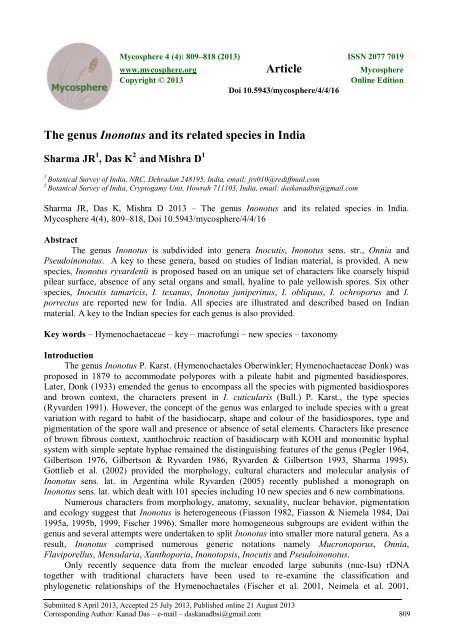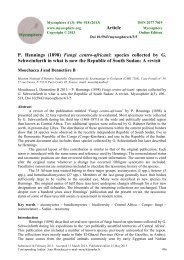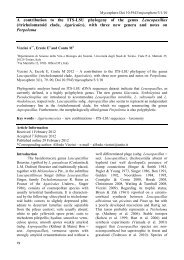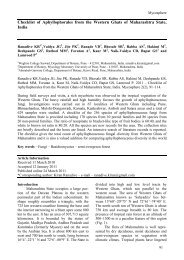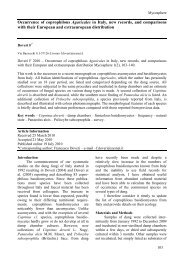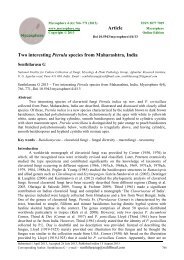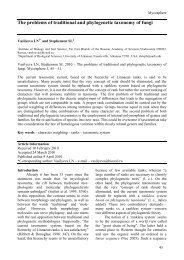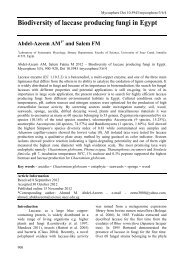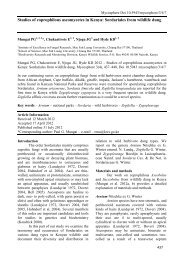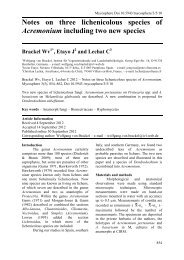The genus Inonotus and its related species in India Article
The genus Inonotus and its related species in India Article
The genus Inonotus and its related species in India Article
Create successful ePaper yourself
Turn your PDF publications into a flip-book with our unique Google optimized e-Paper software.
Mycosphere 4 (4): 809–818 (2013) ISSN 2077 7019<br />
www.mycosphere.org <strong>Article</strong> Mycosphere<br />
Copyright © 2013<br />
Onl<strong>in</strong>e Edition<br />
Doi 10.5943/mycosphere/4/4/16<br />
<strong>The</strong> <strong>genus</strong> <strong>Inonotus</strong> <strong>and</strong> <strong>its</strong> <strong>related</strong> <strong>species</strong> <strong>in</strong> <strong>India</strong><br />
Sharma JR 1 , Das K 2 <strong>and</strong> Mishra D 1<br />
1<br />
Botanical Survey of <strong>India</strong>, NRC, Dehradun 248195, <strong>India</strong>, email: jrs010@rediffmail.com<br />
2<br />
Botanical Survey of <strong>India</strong>, Cryptogamy Unit, Howrah 711103, <strong>India</strong>, email: daskanadbsi@gmail.com<br />
Sharma JR, Das K, Mishra D 2013 – <strong>The</strong> <strong>genus</strong> <strong>Inonotus</strong> <strong>and</strong> <strong>its</strong> <strong>related</strong> <strong>species</strong> <strong>in</strong> <strong>India</strong>.<br />
Mycosphere 4(4), 809–818, Doi 10.5943/mycosphere/4/4/16<br />
Abstract<br />
<strong>The</strong> <strong>genus</strong> <strong>Inonotus</strong> is subdivided <strong>in</strong>to genera Inocutis, <strong>Inonotus</strong> sens. str., Onnia <strong>and</strong><br />
Pseudo<strong>in</strong>onotus. A key to these genera, based on studies of <strong>India</strong>n material, is provided. A new<br />
<strong>species</strong>, <strong>Inonotus</strong> ryvardenii is proposed based on an unique set of characters like coarsely hispid<br />
pilear surface, absence of any setal organs <strong>and</strong> small, hyal<strong>in</strong>e to pale yellowish spores. Six other<br />
<strong>species</strong>, Inocutis tamaricis, I. texanus, <strong>Inonotus</strong> juniper<strong>in</strong>us, I. obliquus, I. ochroporus <strong>and</strong> I.<br />
porrectus are reported new for <strong>India</strong>. All <strong>species</strong> are illustrated <strong>and</strong> described based on <strong>India</strong>n<br />
material. A key to the <strong>India</strong>n <strong>species</strong> for each <strong>genus</strong> is also provided.<br />
Key words – Hymenochaetaceae – key – macrofungi – new <strong>species</strong> – taxonomy<br />
Introduction<br />
<strong>The</strong> <strong>genus</strong> <strong>Inonotus</strong> P. Karst. (Hymenochaetales Oberw<strong>in</strong>kler; Hymenochaetaceae Donk) was<br />
proposed <strong>in</strong> 1879 to accommodate polypores with a pileate habit <strong>and</strong> pigmented basidiospores.<br />
Later, Donk (1933) emended the <strong>genus</strong> to encompass all the <strong>species</strong> with pigmented basidiospores<br />
<strong>and</strong> brown context, the characters present <strong>in</strong> I. cuticularis (Bull.) P. Karst., the type <strong>species</strong><br />
(Ryvarden 1991). However, the concept of the <strong>genus</strong> was enlarged to <strong>in</strong>clude <strong>species</strong> with a great<br />
variation with regard to habit of the basidiocarp, shape <strong>and</strong> colour of the basidiospores, type <strong>and</strong><br />
pigmentation of the spore wall <strong>and</strong> presence or absence of setal elements. Characters like presence<br />
of brown fibrous context, xanthochroic reaction of basidiocarp with KOH <strong>and</strong> monomitic hyphal<br />
system with simple septate hyphae rema<strong>in</strong>ed the dist<strong>in</strong>guish<strong>in</strong>g features of the <strong>genus</strong> (Pegler 1964,<br />
Gilbertson 1976, Gilbertson & Ryvarden 1986, Ryvarden & Gilbertson 1993, Sharma 1995).<br />
Gottlieb et al. (2002) provided the morphology, cultural characters <strong>and</strong> molecular analysis of<br />
<strong>Inonotus</strong> sens. lat. <strong>in</strong> Argent<strong>in</strong>a while Ryvarden (2005) recently published a monograph on<br />
<strong>Inonotus</strong> sens. lat. which dealt with 101 <strong>species</strong> <strong>in</strong>clud<strong>in</strong>g 10 new <strong>species</strong> <strong>and</strong> 6 new comb<strong>in</strong>ations.<br />
Numerous characters from morphology, anatomy, sexuality, nuclear behavior, pigmentation<br />
<strong>and</strong> ecology suggest that <strong>Inonotus</strong> is heterogeneous (Fiasson 1982, Fiasson & Niemela 1984, Dai<br />
1995a, 1995b, 1999, Fischer 1996). Smaller more homogeneous subgroups are evident with<strong>in</strong> the<br />
<strong>genus</strong> <strong>and</strong> several attempts were undertaken to split <strong>Inonotus</strong> <strong>in</strong>to smaller more natural genera. As a<br />
result, <strong>Inonotus</strong> comprised numerous generic notations namely Mucronoporus, Onnia,<br />
Flaviporellus, Mensularia, Xanthoporia, Inonotopsis, Inocutis <strong>and</strong> Pseudo<strong>in</strong>onotus.<br />
Only recently sequence data from the nuclear encoded large subun<strong>its</strong> (nuc-Isu) rDNA<br />
together with traditional characters have been used to re-exam<strong>in</strong>e the classification <strong>and</strong><br />
phylogenetic relationships of the Hymenochaetales (Fischer et al. 2001, Neimela et al. 2001,<br />
Submitted 8 April 2013, Accepted 25 July 2013, Published onl<strong>in</strong>e 21 August 2013<br />
Correspond<strong>in</strong>g Author: Kanad Das – e-mail – daskanadbsi@gmail.com 809
Wagner & Fischer 2001, 2002, Wagner & Ryvarden 2002). DNA data, together with characters<br />
from morphology <strong>and</strong> karyology, have demonstrated <strong>Inonotus</strong> sens. lat. as polyphyletic <strong>and</strong><br />
subdivided <strong>in</strong>to genera: <strong>Inonotus</strong> sens. str. (I. hispidus), Inocutis (I. rheades), Mensularia (M.<br />
radiata), Pseudo<strong>in</strong>onotus (P. dryadeus) <strong>and</strong> Inonotopsis (I. subiculosa).<br />
<strong>The</strong> <strong>genus</strong> Mensularia, which is separated ma<strong>in</strong>ly on the basis of strongly cyanophilous<br />
spores is not accepted because the collections of <strong>Inonotus</strong> radiatus made <strong>and</strong> studied from different<br />
parts of <strong>India</strong> either are acyanophilous or show a weak reaction that is difficult to observe with<br />
cotton blue. <strong>The</strong> <strong>genus</strong> Inonotopsis has no representation <strong>in</strong> <strong>India</strong>. <strong>The</strong> genera <strong>Inonotus</strong> sens. str.,<br />
Inocutis, Pseudo<strong>in</strong>onotus <strong>and</strong> Onnia are accepted for the <strong>species</strong> of the <strong>genus</strong> <strong>Inonotus</strong> sens. lat. on<br />
the basis of studies on fresh field collections from different parts of the country <strong>and</strong> material<br />
deposited <strong>in</strong> various <strong>India</strong>n herbaria.<br />
Materials & Methods<br />
<strong>The</strong> study is ma<strong>in</strong>ly based on material collected dur<strong>in</strong>g the past 25 years <strong>and</strong> study on<br />
specimens ly<strong>in</strong>g <strong>in</strong> the herbaria at AHMA, AMH, BSD, CAL, HCIO, DD, CAL, HCIO, PAN <strong>and</strong><br />
PUN. Colour, texture, taste <strong>and</strong> odour of the basidiocarp are mostly based on fresh material <strong>in</strong> the<br />
field. <strong>The</strong> studied specimens are deposited at the cryptogrammic section of BSI at Dehra Dun<br />
(BSD).<br />
All the materials were exam<strong>in</strong>ed us<strong>in</strong>g an Olympus CX 41 microscope fitted with a draw<strong>in</strong>g<br />
tube. <strong>The</strong> measurements <strong>and</strong> draw<strong>in</strong>gs were made from slide preparations sta<strong>in</strong>ed with cotton blue,<br />
Melzer’s solution <strong>and</strong> 5% KOH. <strong>The</strong> abbreviations used <strong>in</strong>clude: IKI- = negative <strong>in</strong> Melzer’s<br />
solution, CB- = acanophilous, CB+ = cyanophilous. Colour terms follow Rayner (1970) <strong>and</strong><br />
Petersen (1996). Herbarium names used are after Holmgren et al. 1990. <strong>The</strong> abbreviations of<br />
authors of scientific names follow the recent edition of authors of fungal names (available<br />
at:http//www.<strong>in</strong>dex fungorum.org/Names/Names.asp).<br />
A full description of each <strong>species</strong> is given based on <strong>India</strong>n material. Important microscopic<br />
characters of the new records to <strong>India</strong> are illustrated. Basidium length excludes the lengths of the<br />
sterigmata. For measur<strong>in</strong>g the spores, an average of 25 spores were considered. L = mean spore<br />
length (arithmetic average of all spores), W = mean spore width (arithmetic average of all spores),<br />
Q = (variation <strong>in</strong> the L/W ratios between the specimens studied <strong>and</strong> n (number of spores measured<br />
from a given number of specimens).<br />
Taxonomy<br />
Key to genera<br />
1. Spores hyal<strong>in</strong>e; hymenial setae always present…………………………...………………………2<br />
1. Spores coloured; hymenial setae present or absent…………………..…………………………...3<br />
2. Spores strongly dextr<strong>in</strong>oid; context homogeneous………………………………..Pseudo<strong>in</strong>onotus<br />
2. Spores <strong>in</strong>dextr<strong>in</strong>oid; context duplex…………………………………………..…………….Onnia<br />
3. Basidiocarps with a granular core; hymenial setate absent………..………………………Inocutis<br />
3. Basidiocarps without a granular core; hymenial setae present or absent…………..……..<strong>Inonotus</strong><br />
Inocutis Fiasson & Niemela, Karstenia 24(1): 24, 1984<br />
Basidiocarps annual, pileate, upper surface yellowish to brown, hispid, glabrescent to rough;<br />
pore surface yellow to brown; context brown, corky, granular core present at base; hyphal system<br />
monomitic, generative hyphae simple septate, setal hyphae/setae absent; spores pigmented, thickwalled,<br />
smooth, IKI-, CB-, on hardwoods, caus<strong>in</strong>g a white rot.<br />
<strong>The</strong> presence of a granular core at the base of context <strong>and</strong> absence of any setal organs <strong>and</strong><br />
coloured spores are the features which separate this <strong>genus</strong> from the closely <strong>related</strong> <strong>Inonotus</strong>, Onnia,<br />
Mensularia <strong>and</strong> Inonotopsis.<br />
Type <strong>species</strong> – Inocutis rheades (Pers.) Fiasson & Niemela<br />
810
Provisional key to the <strong>India</strong>n <strong>species</strong> of Inocutis<br />
1. Pilear surface usually persistently hispid to woolly strigose; spores 5–6 × 3.5–4 µm; on<br />
Populus……………………………………………………………………………………..I. rheades<br />
1. Pilear surface hispid to tomentose, glabrous with age; spores longer than 7.5 µm; on other<br />
hosts…………………………………………………………………………………………………2<br />
2. Pilear surface becom<strong>in</strong>g black <strong>and</strong> brittle with age or dry<strong>in</strong>g; on Tamarix……………I. tamaricis<br />
2. Pilear suface unchang<strong>in</strong>g on dry<strong>in</strong>g or with age; on other hosts………………………………….3<br />
3. Pilear suface smooth <strong>and</strong> rusty brown with age; on oaks……………………………..I. dryophilus<br />
3. Pilear suface black scaly; spores7–10 × 4.5–6µm; on Prosopis <strong>and</strong> Acacia…………….I. texanus<br />
Inocutis tamaricis (Pat.) Fiasson & Niemela, Karstenia 24(1): 25, 1984; Xanthochrous tamaricis<br />
Pat., Bull. Soc. Myc. France 20: 51, 1904 = <strong>Inonotus</strong> tamaricis (Pat.) Maire, Bull. Soc. Sci. natur.<br />
Maroc 14: 89, 1938 Figs 12–16<br />
Basidiocarps annual, solitary or sometimes <strong>in</strong> groups, soft when fresh, brittle on dry<strong>in</strong>g, 40–<br />
80 mm wide <strong>and</strong> broad, up to 20 mm thick at base; upper surface hispid to villose becom<strong>in</strong>g<br />
glabrous <strong>and</strong> black <strong>and</strong> brittle with age or on dry<strong>in</strong>g, rusty to c<strong>in</strong>namon brown; pore surface rusty<br />
brown becom<strong>in</strong>g black with age, pores angular to lacerate, 1–3 per mm, tubes rusty brown, up to 20<br />
mm deep; context zonate with alternat<strong>in</strong>g light <strong>and</strong> dark zones, with a dist<strong>in</strong>ct granular core of<br />
<strong>in</strong>termixed brown <strong>and</strong> whitish mycelium, with a th<strong>in</strong> layer of fibrous, yellowish brown tissue on the<br />
surface between the core <strong>and</strong> tube layer.<br />
Hyphal system monomitic, hyphae of fibrous context mostly pale yellowish brown, th<strong>in</strong> to<br />
moderarly thick-walled, septate with rare branch<strong>in</strong>g; hyphae of granular core of two types: some<br />
dark brown, thick-walled, break<strong>in</strong>g <strong>in</strong>to small fragments, 5–10 μm diam., others hyal<strong>in</strong>e to pale<br />
yellow, th<strong>in</strong>-walled, simple-septate, some <strong>in</strong>flated <strong>and</strong> distorted, 3–12 μm diam.; tramal hyphae<br />
mostly pale yellowish, th<strong>in</strong>-walled simple septate with rare branch<strong>in</strong>g, 3–4 μm wide; hymenial<br />
setae absent; basidia narrowly clavate, 4-sterigmate; spores rusty brown to pale umber, thickwalled,<br />
ovoid to ellipsoid, IKI-, CB-, (5.6–)6–7.3(–7.7) × (3.8–)4.5–6(–6.2) µm, L = 6.81 µm, W =<br />
5.27 µm, Q = 1.25–1.36, (n = 25/1).<br />
Specimens exam<strong>in</strong>ed – INDIA, Tamil Nadu, Nilgiri, Burliar, on base of a Tamaricis tree, 7<br />
Dec 2012, J.R. Sharma, JRS 1108 (BSD); ibid., Coimbatore, Annakutti, on base of a Tamaricis<br />
tree, 10 Dec 2012, J.R. Sharma, JRS 509 (BSD).<br />
Remarks – This <strong>species</strong> grows on liv<strong>in</strong>g or dead wood of Tamaricis <strong>in</strong> the pla<strong>in</strong>s. <strong>The</strong> host<br />
<strong>and</strong> the granular core are sufficient to recognize this <strong>species</strong> <strong>in</strong> the field. <strong>The</strong> <strong>species</strong> is <strong>related</strong> to I.<br />
rheades, but the later grows on Populus, has smaller spores <strong>and</strong> persistently hispid to strigose pilear<br />
surface. <strong>The</strong> granular core <strong>in</strong> the present <strong>species</strong> is quite small. I. tamaricis is conf<strong>in</strong>ed to tropical<br />
areas.<br />
Inocutis texanus (Murr.) Sed. Mart<strong>in</strong>ez, Mycotaxon 96: 3, 2006; <strong>Inonotus</strong> texanus Murr., Bull.<br />
Torrey Bot. Club 31: 597, 1904 Figs 19–24<br />
Basidiocarps annual, sessile ungulate to applanate, up to 50 mm wide 80 mm broad <strong>and</strong> 40<br />
mm thick near the base; upper surface tomentose to soft velut<strong>in</strong>ate, soon becom<strong>in</strong>g glabrous<br />
crack<strong>in</strong>g radially <strong>and</strong> concentrically <strong>in</strong>to angular scales, light to medium brown; pore surface<br />
yellowish brown when young becom<strong>in</strong>g dark brown to blackish with age, pores circular to angular,<br />
1–3 per mm, dissepiments thick becom<strong>in</strong>g lacerate with age, tube layer concolorous with the<br />
fibrous context, tubes 15–20 mm deep, brittle; context with a dist<strong>in</strong>ct granular core of <strong>in</strong>termixed<br />
white <strong>and</strong> brown tissue, fibrous context yellowish brown, usually up to 10 mm thick.<br />
Hyphal system monomitic, generative hyphae pale yellowish brown, th<strong>in</strong> to moderately thickwalled,<br />
4–7 µm wide, hyphae of granular core of two types: some dark brown, thick-walled,<br />
break<strong>in</strong>g <strong>in</strong>to short fragments, 7–15 µm diam., others hyal<strong>in</strong>e to pale yellowish, th<strong>in</strong> to moderately<br />
thick-walled, simple-septate, some <strong>in</strong>flated <strong>and</strong> distorted 4–12 μm diam.; tramal hyphae mostly<br />
pale yellowish, th<strong>in</strong> -walled, simple septate, with rare branch<strong>in</strong>g, 3–5 µm wide; hymenial setae<br />
811
none; basidia clavate, 4-sterigmate, 16–22 × 5–6 μm; spores yellowish brown, thick-walled, ovoid<br />
to ellipsoid, IKI- ,CB-, (6.7–)7–10(–10.3) × (4.1–)4.5-6(–6.2 ) μm, L = 8.72 µm, W = 5.32 µm, Q =<br />
1.55–1.65, (n = 25/1).<br />
Specimens exam<strong>in</strong>ed – INDIA, Tamil Nadu, Coimbatore, Annakutti, on a fallen trunk of<br />
Acacia, 28 Nov. 2012, J.R. Sharma, JRS 1407 (BSD); ibid, Koller, on a dead st<strong>and</strong><strong>in</strong>g trunk of<br />
Prosopis, 30 Nov. 2012, J.R. Sharma, JRS 1481 (BSD); ibid, Uttrakh<strong>and</strong>, Dehradun, Rajaji<br />
National Park, On dead trunk of Acacia, 21 Sept. 2011, J.R. Sharma, JRS 718 (BSD).<br />
Remarks – This <strong>species</strong> has been repeatedly found grow<strong>in</strong>g on dead woods of Acacia <strong>and</strong><br />
Prosopis. Inocutis texanus differs from closely <strong>related</strong> I. dryophilus <strong>in</strong> hav<strong>in</strong>g larger basidiocarps,<br />
dist<strong>in</strong>ctive rimose scaly nature of upper surface <strong>and</strong> <strong>its</strong> host relationships.<br />
<strong>Inonotus</strong> P. Karst., Meddn Soc. Faunna Flora fenn. 5: 39, 1879<br />
Basidiocarps annual to rarely perennial, resup<strong>in</strong>ate, effused-reflexed or pileate, sessile to<br />
rarely stipitate, solitary to imbricate, corky fleshy to woody hard <strong>and</strong> brittle on dry<strong>in</strong>g; pileus small<br />
to medium sized, dimidiate, applanate to conchate; upper surface glabrous, tomentose to hispid,<br />
yellowish to dark reddish brown, usually without a crust, hymenophore poroid; pore surface brown,<br />
pores 2–10 per mm; context rusty to c<strong>in</strong>namon brown, mycelial core absent; hyphal system<br />
monomitic, generative hyphae yellowish to brownish, simple septate; setal hyphae present or<br />
absent; hymenial or tramal setae present or absent; cystidia none; spores globose to ellipsoid, rarely<br />
cyl<strong>in</strong>drical, smooth, hyal<strong>in</strong>e to yellowish or brown; on dead <strong>and</strong> liv<strong>in</strong>g hardwoods or coniferous<br />
woods, caus<strong>in</strong>g a white rot.<br />
<strong>The</strong> <strong>genus</strong> is easy to recognize by <strong>its</strong> annual basidiocarps with a fibrous to soft or fragile<br />
consistency. <strong>The</strong> hyphae are monomitic <strong>and</strong> generally are wider than those of Phell<strong>in</strong>us which<br />
usually has woody, perennial basidiocarps with dimitic hyphal system.<br />
Type <strong>species</strong> – <strong>Inonotus</strong> hispidus (Bull.: Fr.) P. Karst.<br />
Provisional key to the <strong>India</strong>n <strong>species</strong> of <strong>Inonotus</strong><br />
1. Setal hyphae present………………………………………………………………………………2<br />
1. Setal hyphae absent………………………………………………………………………………..6<br />
2. Ptychogastric anamorph with abundant chamydospores commonly produced…………….I. rickii<br />
2. Ptychogastric anamorph absent……………………………………………………………………3<br />
3. Branched setal hyphae present on pilear surface……………………………………...I. cuticularis<br />
3. Branched setal hyphae absent on pilear surface…………………………………………………..4<br />
4. Setal hyphae present only <strong>in</strong> dissepiments………………………………………….I. patouillardii<br />
4. Setal hyphae present both <strong>in</strong> context <strong>and</strong> dissepiments…………………………………………...5<br />
5. Basidiocarps effused-reflexed to pileate; spores 5–7 × 4–5.5 µm; context not<br />
duplex…………………………………………………………………………………...I. glomeratus<br />
5. Basidiocarps applanate with a attenuated base; spores 7.5–9 × 5.5–7 µm; context<br />
duplex…………………………………………………………………………………...I. ochroporus<br />
6. Hymenial setae present……………………………………………………………………………7<br />
6. Hymenial setae absent……………………………………………………………………………11<br />
7. Hymenial setae hooked……………………………………………………………………………8<br />
7. Hymenial setae straight……………………………………………………………………………9<br />
8. Pores 4–6 per mm; spores 5–7.5 × 4–5.5 µm; marg<strong>in</strong> not bright yellow…………...I. hamusetulus<br />
8. Pores 6–8 per mm; spores 4–4.5 × 3.5µm; marg<strong>in</strong> bright yellow……………………….I. radiatus<br />
9. Basidiocarps resup<strong>in</strong>ate; develop<strong>in</strong>g beneath bark or sapwood………………………...I. obliquus<br />
9. Basidiocarps sessile or effused-reflexed; not develop<strong>in</strong>g as above……………………………...10<br />
10. Pilear surface strongly hispid <strong>and</strong> rema<strong>in</strong><strong>in</strong>g more or less so at maturity; setae not with lateral<br />
projections; spores 8–11 × 6–8 µm…………………………………………………….I. hispidus<br />
10. Pilear surface tomentose to glabrous at maturity, delimited on upper surface by a th<strong>in</strong> black<br />
crust; setae ventricose with lateral projections; spores 5.5–7.5 × 4.5–5.5 µm….I. diverticuloseta<br />
11. Spores 8 µm or longer…………………………………………………………………………..12<br />
812
11. Spores not exceed<strong>in</strong>g 7 µm……………………………………………………………………..13<br />
12. Pilear surface hispid turn<strong>in</strong>g black <strong>and</strong> brittle on dry<strong>in</strong>g or with age; spores 8–11 × 6–8 µm; on<br />
oaks……………………………………………………………………………………..I. hispidus<br />
12. Pilear surface tomentose to glabrescent, unchanged on dry<strong>in</strong>g or with age; spores 7–8.9 × 5–6.5<br />
µm; on Tamarix…………………………………………………………………….I. subhispidus<br />
13. Pilear surface coarsely hispid, form<strong>in</strong>g a coarse hispid tomentum composed of fasciculated<br />
groups of agglut<strong>in</strong>ated hyphae; spores hyal<strong>in</strong>e to pale yellowish……………………I. ryvardenii<br />
13. Pilear surface not as above; spores dark brown to rusty brown………………………………...14<br />
14. Pore surface <strong>and</strong> tubes oblique, appear<strong>in</strong>g black <strong>and</strong> brittle at least <strong>in</strong> dried material; on roots of<br />
Juniperus……………………………………………………………………………I. juniper<strong>in</strong>us<br />
14. Pore surface <strong>and</strong> tubes not oblique, unchanged on dry<strong>in</strong>g or with age; pores 4–7 per mm; on<br />
other hosts………………………………………………………………………………………15<br />
15. Pilear surface multizonate; context bright ochraceous tawny; pores 5–7 per mm……I. porrectus<br />
15. Pilear surface azonate; context c<strong>in</strong>namon brown; pores 4–5 per mm………………I. tenuicarnis<br />
<strong>Inonotus</strong> juniper<strong>in</strong>us Murr., North Am. Fl. 9: 88, 1908 Figs 25, 26<br />
Basidiocarps annual, pileate, sessile to dimidiate to flabelliform or substipitate, 30–70 mm<br />
wide <strong>and</strong> long, 5–10 mm thick, soft <strong>and</strong> flexible when fresh, brittle <strong>and</strong> rigid when dry; pilear<br />
surface rusty to umber brown, f<strong>in</strong>ely tomentose when young, becom<strong>in</strong>g glabrous with age, radially<br />
rugulose with age, weakly zonate, slightly <strong>in</strong>crusted with age, marg<strong>in</strong> acute, broadly sterile; pore<br />
surface deep rusty to umber brown, darken<strong>in</strong>g on dry<strong>in</strong>g, pores angular, becom<strong>in</strong>g dentate <strong>and</strong><br />
irregular on dry<strong>in</strong>g, 3–5 per mm, tubes concolorous, 5–7 mm deep, darken<strong>in</strong>g <strong>and</strong> becom<strong>in</strong>g<br />
oblique with age <strong>and</strong> dry<strong>in</strong>g; context rusty brown to umber brown, fibrous <strong>and</strong> fragile, zonate <strong>in</strong><br />
well developed specimens, 4–8 mm thick.<br />
Hyphal system monomitic, generative hyphae golden to rusty brown, thick-walled 3–6 μm<br />
wide; hymenial setae absent; basidia 10–20 × 4–7 μm, spores rusty brown, slightly thick-walled,<br />
ellipsoid, IKI -, CB-, (4.7–)5–6.2(–5.9) × (3.7–)4–5.3(–5.5) μm, L = 5.75 µm, W = 4.65 µm, Q =<br />
1.20–1.28, (n = 25/2).<br />
Specimens exam<strong>in</strong>ed – INDIA, Sikkim, East Sikkim, Yongari, on the roots of Juniperus, 21<br />
Sept. 1996, J.R. Sharma, JRS 1206 (BSD); ibid, Uttrakh<strong>and</strong>, Chamoli, Panwali, on roots of<br />
Juniperus, 13 Sept. 2008, J. R. Sharma, JRS 1307 (BSD).<br />
Remarks – This <strong>species</strong> grows on roots of Juniperus at high altitudes. <strong>The</strong> oblique pore<br />
surface <strong>and</strong> tubes, blacken<strong>in</strong>g with age, absence of any setal elements <strong>and</strong> the host are the<br />
dist<strong>in</strong>guish<strong>in</strong>g features of this <strong>species</strong>.<br />
<strong>Inonotus</strong> obliquus (Pers.: Fr.) Pilat, Atl. Champ. Eur. lll, p. 572, 1942; Boletus obliquus Pers., Syn.<br />
Fung., p. 548, 1801; Polyporus obliquus Pers.: Fr., Syst. Mycol., p. 378, 1821 Figs 9–11<br />
Basidiocarps annual, resup<strong>in</strong>ate, becom<strong>in</strong>g widely effused, develop<strong>in</strong>g only once beneath the<br />
bark or outer layers of wood on dead st<strong>and</strong><strong>in</strong>g or fallen trees, eventually ruptur<strong>in</strong>g the bark,<br />
coriaceous fleshy <strong>in</strong> fresh specimens, hard <strong>and</strong> brittle on dry<strong>in</strong>g, consist<strong>in</strong>g almost entirely of tubes<br />
runn<strong>in</strong>g oblique to the substrate becom<strong>in</strong>g easily separable, marg<strong>in</strong> fertile; pore surface yellowish<br />
brown, becom<strong>in</strong>g dark reddish brown, pores circular, 6–8 per mm, dissepiments thick, entire,<br />
becom<strong>in</strong>g th<strong>in</strong> <strong>and</strong> lacerate, tube layer dark reddish brown, brittle, 2–3 mm deep; context if present<br />
very th<strong>in</strong>, bright yellowish brown, fa<strong>in</strong>tly zonate corky, up to 3 mm thick; sterile conks black, hard<br />
<strong>and</strong> strongly cracked.<br />
Hyphal system monomitic, generative hyphae dark brown, th<strong>in</strong> to moderately thick-walled,<br />
freely branched, 3–4 μm wide; basidia broadly clavate, 15–18 × 9–11 μm; hymenial setae scattered,<br />
scarcely project<strong>in</strong>g or imbedded, subulate to ventricose, 15–25 × 5–7 μm; basidiospores hyal<strong>in</strong>e to<br />
pale brownish, ovoid to broadly ellipsoid, IKI-, CB-, (8.8–)9–10(–10.4) × (5.0–)5.5–6.5(–6.8) μm,<br />
L = 9.6 μm,W = 6.10 μm, Q = 1.53–1.64, (n = 25/2).<br />
813
Specimens exam<strong>in</strong>ed – INDIA, Uttrakh<strong>and</strong>, Chamoli, Chirbasa, on a dead st<strong>and</strong><strong>in</strong>g tree of<br />
Betula utilis, 10 Sept. 1998, J.R. Sharma, JRS 506 (BSD); ibid, Tehri, Virod, on a dead st<strong>and</strong><strong>in</strong>g<br />
tree of Betula utilis, 12 Sept. 1993, J.R. Sharma, JRS 3012 (BSD)<br />
Remarks – <strong>The</strong> wood attacked by I. oblquus is pierced through by dark l<strong>in</strong>es <strong>and</strong> sta<strong>in</strong>ed<br />
yellowish white. <strong>The</strong> habit of the fungus is so characteristic <strong>in</strong> appearance that it cannot be<br />
confused with any other <strong>species</strong>. After the basidiocarps emerge from under the bark, the fungus<br />
then dries up, cracks <strong>and</strong> breaks <strong>in</strong>to pieces match<strong>in</strong>g <strong>in</strong> colour with I. radiatus. <strong>The</strong> cracks <strong>in</strong> the<br />
wood are filled with mycelium <strong>and</strong> the pressure of the grow<strong>in</strong>g mycelium ultimately spl<strong>its</strong> the<br />
wood <strong>in</strong>to plates along the cracks. This <strong>species</strong> is found grow<strong>in</strong>g frequently on both the liv<strong>in</strong>g <strong>and</strong><br />
dead trees of Betula utilis near the tree l<strong>in</strong>e <strong>in</strong> the Himalayas. <strong>Inonotus</strong> obliquus produces<br />
conspicuous black sterile conks on the liv<strong>in</strong>g trees, the fungus <strong>in</strong>vades, kills <strong>and</strong> decays the sap<br />
wood weaken<strong>in</strong>g the tree which then f<strong>in</strong>ally dies <strong>and</strong> the next summer the basidiocarps develop<br />
once under the disrupted bark. <strong>The</strong> basidiocarps weather rapidly <strong>and</strong> are generally quickly eaten by<br />
<strong>in</strong>sects, <strong>and</strong> are rare to f<strong>in</strong>d even <strong>in</strong> the st<strong>and</strong>s where <strong>in</strong>fected trees are numerous.<br />
<strong>Inonotus</strong> ochroporus (Van der Byl) Pegler, Trans. Brit. Mycol. Soc. 47: 183, 1964; Polyporus<br />
ochroporus Van der Byl, S. Afr. J. Sci. 18: 269, 1922 Figs 6–8<br />
Basidiocarps annual, pileate, broadly attached, solitary to imbricate, 100–150 mm broad,<br />
120–170 mm wide <strong>and</strong> up to 20 mm thick, soft <strong>and</strong> spongy when fresh, hard <strong>and</strong> brittle on dry<strong>in</strong>g,<br />
pileus dimidiate to attenuated towards the base, convex; upper surface soft <strong>and</strong> pubescent when<br />
young, becom<strong>in</strong>g hard <strong>and</strong> brittle with age, mostly with an agglut<strong>in</strong>ated cuticle, sometimes<br />
concentrically zoned <strong>and</strong> partly radially stiate, light brown, fulvous to dark brown, marg<strong>in</strong> th<strong>in</strong> to<br />
rather thick entire or slightly lobed; pore surface ochre yellow to dark brown sometimes with a rosy<br />
t<strong>in</strong>t, pore angular to irregular, 2–5 per mm, dissepiments th<strong>in</strong>, entire or dentate, tubes 2–6 mm deep,<br />
ochraceous-yellow; context up to 10 mm thick, duplex <strong>in</strong> young specimens, upper part soft <strong>and</strong><br />
ochraceous to golden brown mostly separated from the lower part by a th<strong>in</strong>, often <strong>in</strong>dist<strong>in</strong>ct black<br />
zone, becom<strong>in</strong>g more prom<strong>in</strong>ent with age <strong>and</strong> closer to the base of the basidiocarp, lower part<br />
sh<strong>in</strong>y, radially fibrous <strong>and</strong> hard, dark c<strong>in</strong>namon brown.<br />
Hyphal system monomitic, generative hyphae hyal<strong>in</strong>e to rusty brown, branched, 2–6 μm<br />
wide; setal hyphae prom<strong>in</strong>ent <strong>in</strong> the dissepiments, rather rare <strong>and</strong> often difficult to f<strong>in</strong>d <strong>in</strong> the upper<br />
part of the context, mostly conf<strong>in</strong>ed to the basal part of the pileus, acute thick-walled, 10–18 μm<br />
wide <strong>and</strong> up to 300 μm long, mostly embedded, but also obliquely project<strong>in</strong>g <strong>in</strong>to the hymenium,<br />
rarely forked <strong>in</strong> the upper part, hymenial setae apparently absent but <strong>in</strong> some collections they are<br />
found from rare to common, acute, subventricose, thick-walled dark brown, 12–25 × 6–9 μm;<br />
basidia broadly clavate, 4-sterigmate 15–18 × 6–10 μm; spores abundant, subglobose to globose<br />
yellowish brown, thick-walled, IKI-, CB-, (5.7–)6–9(–9.3) × (4.6–)5–7(–7.3) μm, L = 7.85 μm ,W<br />
= 6.2 μm, Q = 1.22–1.32, (n = 25/2).<br />
Specimens exam<strong>in</strong>ed – INDIA, Tamil Nadu, Coimbatore, Pullachi, on a dead rott<strong>in</strong>g trunk of<br />
Ficus, 6 Dec. 2012, J.R. Sharma, JRS 712 (BSD); ibid, Kavai Courtalum, on a dead trunk of Ficus,<br />
7 Dec. 2012, J.R. Sharma, JRS 917 (BSD).<br />
Remarks – This <strong>species</strong> usually grows on dead <strong>and</strong> rott<strong>in</strong>g trunks of Ficus <strong>and</strong> rarely on <strong>and</strong><br />
other hardwoods. <strong>The</strong> <strong>species</strong> is separated on the basis of larger spores, dist<strong>in</strong>ct duplex consistency<br />
of the context <strong>and</strong> presence of setal hyphae <strong>and</strong> hymenial setae. It is closely <strong>related</strong> to I.<br />
patouillardii but differs <strong>in</strong> hav<strong>in</strong>g the setal hyphae both <strong>in</strong> the context <strong>and</strong> the dissepiments, smaller<br />
pores <strong>and</strong> spores. Further, I. patouillardii has a temperate distribution unlike the present <strong>species</strong><br />
which is conf<strong>in</strong>ed to tropical areas.<br />
<strong>Inonotus</strong> porrectus Murr., Tropical Polypores p. 68, 1915 Figs 17, 18<br />
Basidiocarps annual, flbelliform or substipitate with a narrowed base, pilei circular to<br />
dimidiate, s<strong>in</strong>gle or imbricate, 20–35 mm wide, up tp 40 mm broad <strong>and</strong> 10–30 mm thick; pilear<br />
surface bright yellowish brown, zonate, f<strong>in</strong>ely tomentose, marg<strong>in</strong> acute to rounded, concolorous,<br />
sta<strong>in</strong><strong>in</strong>g dark brown on bruis<strong>in</strong>g <strong>and</strong> on dry<strong>in</strong>g; pore surface dull purplish brown, pores circular to<br />
814
angular 5–6 per mm, dissepiments th<strong>in</strong>, entire tube layer purplish brown, decurrent on the narrowed<br />
base, 2–5 mm deep; context golden brown, lustrous, zonate, firm, fibrous brown to dark purplish<br />
brown, up to 20 mm thick.<br />
Hyphal system monomitic, hyphae th<strong>in</strong> to moderately thick-walled, hyal<strong>in</strong>e to pale yellowish<br />
4–8.5 µm wide, tramal hyphae difficult to separate; hymenial setae absent; basidia broadly clavate,<br />
4-sterigmate, 12–18 x 5–6 µm; basidiospores broadly ellipsoid to ovoid, reddish brown, IKI-, CB-,<br />
(3.9–)4.5–6(–6.2) × (3.2–)3.5–4.5(–4.7) µm, L = 5.6 µm, W = 3.95 µm, Q = 1.38–1.47 (n = 25/2).<br />
Specimens exam<strong>in</strong>ed- INDIA, Tamil Nadu, Coimbatore, Annakutti, on a fallen hardwood tree<br />
trunk, 30 Nov. 2012, J.R. Sharma, JRS 1204 (BSD); ibid, Koller, on fallen trunk of a hardwood<br />
tree, 30 Nov. 2012, J.R. Sharma, JRS 1307, 1302 (BSD).<br />
Remarks – <strong>The</strong> substipitate basidiocarps grow<strong>in</strong>g on dead hardwoods, multizonate pilear<br />
surface, absence of any setigerous elements <strong>and</strong> smaller spores, bright golden yellow, lustrous<br />
context <strong>and</strong> darker purplish brown tube layer are the dist<strong>in</strong>guish<strong>in</strong>g characters of this <strong>species</strong>. <strong>The</strong><br />
closely <strong>related</strong> I. tenuicarnis has azonate pilear surface, c<strong>in</strong>namon-brown context, larger spores <strong>and</strong><br />
pores.<br />
<strong>Inonotus</strong> ryvardenii J.R. Sharma & D. Mishra, sp. nov. Figs 1–5, 27, 28<br />
MycoBank – MB 803349<br />
Etymology – Named <strong>in</strong> honour of Prof. Leif Ryvarden, University of Oslo who has<br />
contributed greatly to the knowledge of these fungi.<br />
Basidiocarps annual, pileate, solitary or often imbricate or laterally confluent, sessile,<br />
dimidiate to almost ungulate, soft when fresh, corky when dry, broadly attached, form<strong>in</strong>g<br />
composite structures, <strong>in</strong>dividual pilei 40–50 mm wide, 60–70 mm long <strong>and</strong> 10–20 mm thick near<br />
the base, upper surface coarsely hispid, form<strong>in</strong>g a coarse hispid tomentum composed of fasciculate<br />
groups of agglut<strong>in</strong>ated hyphae, up to 3 mm deep, yellowish brown, becom<strong>in</strong>g dark reddish brown<br />
to blackish towards the base, marg<strong>in</strong> obtuse, entire, lighter <strong>in</strong> colour, slightly curved; pore surface<br />
plane to concave, chestnut brown, with a narrow sterile marg<strong>in</strong>, pores 5–6 per mm, round to<br />
angular, tubes nonstratose, dist<strong>in</strong>ct <strong>and</strong> lighter than context, yellowish brown, brittle, 8–10 mm<br />
deep; context th<strong>in</strong>ner than the tube layer, consist<strong>in</strong>g of two layers not separated by a black l<strong>in</strong>e,<br />
lower layer dark brown, tough-corky, with a silky sheen, without any white flecks, 2–4 mm thick,<br />
upper part soft, form<strong>in</strong>g a tomentum of agglut<strong>in</strong>ated hyphae, 2–6 mm thick.<br />
Hyphal system monomitic, contextual generative hyphae predom<strong>in</strong>antly unbranched, thickwalled,<br />
fairly loosely <strong>in</strong>terwoven, 8–10 μm wide, dark brown, these <strong>in</strong>terlaced with narrower, pale<br />
brown, fairly branched <strong>and</strong> contorted hyphae, 3–6 μm wide, hyphae <strong>in</strong> the tomentum dark thickwalled<br />
to solid, wider up to 16 μm, tramal generative hyphae of one type only agglut<strong>in</strong>ated, parallel<br />
th<strong>in</strong> to firm-walled, frequently septate with occasional branch<strong>in</strong>g, pale golden brown, 4–6 μm wide,<br />
simple septate; setae <strong>and</strong> setal hyphae absent; basidia broadly ellipsoid, 4-sterigmate, 12–16 × 8–10<br />
μm, simple sptate at the base; spores present abundantly, broadly ellipsoid, hyal<strong>in</strong>e to pale<br />
yellowish, smooth, th<strong>in</strong> to moderately thick-walled, IKI-, CB- (3.9–)4.5–5(–5.4) × (2.95–)3–4(–<br />
4.3) μm, L = 4.77 μm, W = 3.67 μm, Q = 1.24–1.34, (n = 25/1).<br />
Specimens exam<strong>in</strong>ed – INDIA, Uttarakh<strong>and</strong>, Na<strong>in</strong>ital, Kaladungi, on base of a rott<strong>in</strong>g stump<br />
of Shorea robusta Roxb. ex Geartn.f., 7 Aug. 2010, J.R. Sharma, JRS 15034 (holotype, BSD);<br />
ibid., Uttarakh<strong>and</strong>, Na<strong>in</strong>ital, Kaladungi, on base of a rott<strong>in</strong>g stump of angiosperm tree, 15 Aug.<br />
2011, J.R. Sharma, JRS 12037 (BSD); ibid., Uttarakh<strong>and</strong>, Dehradun, on fallen wood of Delonix<br />
regia (Bojer) Raf., 10 Sept. 2011, J.R. Sharma, JRS 13027 (BSD).<br />
Remarks – <strong>Inonotus</strong> ryvardenii is characterized by <strong>its</strong> pileate sporocarps with coarsely hispid<br />
pilear surface composed of fasciculated groups of hyphae, double layered context, absence of any<br />
setal elements <strong>and</strong> broadly ellipsoid hyal<strong>in</strong>e to pale yellowish spores. This <strong>species</strong> may be confused<br />
with I. hispidus (Bull.) P. Karst. <strong>and</strong> I. subhispidus Pegler & Reid <strong>in</strong> the characters of pilear<br />
surface. But the former has hymenial setae, larger pores (1–3 per mm) <strong>and</strong> thick-walled dark brown<br />
larger spores (8–11 × 6–8 μm) while <strong>in</strong> the latter, the context is permeated with whitish flecks<br />
beside larger pores (2–3 per mm), persistently dark brown pilear surface, which does not become<br />
815
Figs 1–18 – 1–5 – <strong>Inonotus</strong> ryvardenii (JRS 15034). 1 Tramal hyphae. 2 Contexual hyphae. 3<br />
Hyphae from pilear surface. 4 Spores. 5 Chlamydospores. 6–8 – <strong>Inonotus</strong> ochroporus (JRS 712). 6<br />
Schematic draw<strong>in</strong>g of hymenium. 7 Hymenial setae. 8 Spores. 9–11 – <strong>Inonotus</strong> obliquus (JRS<br />
3012) 9 Hymenial setae. 10 Basidiospores. 11 Generative hyphae. 12–16 – Inocutis tamaricis (JRS<br />
509) 12 Spores. 13 Tramal hyphae. 14 Contextual hyphae. 15 Hyal<strong>in</strong>e hyphae from granular core.<br />
16 Fragments of thick-walled hyphae from granular core. 17–18 – <strong>Inonotus</strong> porrectus (JRS 1204)<br />
17 Spores. 18 Generative hyphae.<br />
black with age, <strong>and</strong> larger (7–9 × 5–6.5 μm) dark brown spores. I. ungulatus Ryvarden described<br />
from Australia also lack setal elements <strong>and</strong> has similar spore characters but has a black cuticle on<br />
the pilear surface <strong>and</strong> above all a mycelia core <strong>in</strong> the context. I. mikalodi (Lloyd) Nunez &<br />
Ryvarden known from Japan <strong>and</strong> Taiwan also lacks setal elements but has larger pores <strong>and</strong> rusty<br />
brown spores <strong>and</strong> different host characters. Similarly, I. pirisporus Pegler has subglobose piriform<br />
spores <strong>and</strong> different host characters.<br />
Onnia P. Karst., Bidr. Kann. F<strong>in</strong>l. Nat. Folk 48: 326, 1889<br />
Basidiocarps annual, sessile or stipitate; pilear suface yellowish to rusty brown; tomentose,<br />
velut<strong>in</strong>ate to rough; pore suface brown to chestnut brown; context rusty brown, duplex upper layer<br />
spongy, lower layer corky; hyphal system monomitic, generative hyphae simple septate; setal<br />
hyphae absent; hymenial setae present; cystidia none; spores cyl<strong>in</strong>drical or ellipsoid, th<strong>in</strong>-walled,<br />
hyal<strong>in</strong>e, smooth, IKI-; on liv<strong>in</strong>g or dead woods of gymnosperms <strong>and</strong> angiosperms or on ground<br />
close to them caus<strong>in</strong>g a white rot.<br />
<strong>The</strong> <strong>genus</strong> Onnia is homogeneous <strong>and</strong> is ma<strong>in</strong>ly separated on the basis of duplex context <strong>and</strong><br />
presence of hymenial setae. It resembles Inonotopsis <strong>in</strong> hyal<strong>in</strong>e <strong>and</strong> th<strong>in</strong>-walled spores, but differs<br />
<strong>in</strong> that the former lacks setae while setae are present <strong>in</strong> the latter. <strong>The</strong> <strong>genus</strong> <strong>Inonotus</strong> has thick-<br />
816
Figs 19–28 – 19–24 Inocutis texanus (JRS 1481). 19 Spores. 20 Tramal hyphae. 21 Contextual<br />
hyphae. 22 Gloeopleurous hyphae. 23 Hyal<strong>in</strong>e hyphae from granular core. 24 Fragments of thickwalled<br />
hyphae from granular core. 25–26 – <strong>Inonotus</strong> juniper<strong>in</strong>us (JRS 1206). 25 Spores. 26<br />
generative hyphae. 27–28 – Basidiocarps of <strong>Inonotus</strong> ryvardenii (JRS 15034) grow<strong>in</strong>g at the base<br />
of Shorea robusta tree. 27 Dorsal view. 28 Ventral view.<br />
walled spores while Inocutis has a granular core. In the presence of stipe, the <strong>species</strong> of Onnia<br />
often resemble Coltricia but the presence of hymenial setae <strong>in</strong> Onnia differentiate them.<br />
Type <strong>species</strong>: Onnia tomentosa (Fr.) P. Karst.<br />
Provisional key to the <strong>India</strong>n <strong>species</strong> of Onnia<br />
1. Spores cyl<strong>in</strong>drical……………………………………………………………………….O. flavidus<br />
1. Spores ovoid to ellipsoid………………………………………………………………………….2<br />
2. Basidiocarps usually grow<strong>in</strong>g grow<strong>in</strong>g s<strong>in</strong>gly; hymenial setae hooked……………...O. circ<strong>in</strong>atus<br />
2. Basidiocarps usually grow<strong>in</strong>g <strong>in</strong> groups; hymenial setae not hooked…………………………….3<br />
3. Hymenial setae 45–65(–70) × 7–12 μm, tips straight; spores 4.5–6 × 3–4 µm……...O. tomentosa<br />
3. Hymenial setae 27–30(–35) × 7–9 μm, tips straight or dichotomously split; spores 5–7 × 4–6<br />
µm…………………………………………………………………………………………..O. vallata<br />
Pseudo<strong>in</strong>onotus T. Wagner & M. Fischer, Mycol. Res. 105(7): 781, 2001<br />
Basidiocarps annual, pileate, pilear surface velut<strong>in</strong>ate to smooth, zonate or azonate, crack<strong>in</strong>g<br />
at maturity, context homogeneous; hyphal system monomitic, generative hyphae hyal<strong>in</strong>e to<br />
yellowish brown, th<strong>in</strong> to thick-walled, setal hyphae absent, hymenial setae, hyal<strong>in</strong>e, thick-walled,<br />
strongly dextr<strong>in</strong>oid <strong>and</strong> cyanophilous, usually on angiosperms caus<strong>in</strong>g white rot.<br />
Type <strong>species</strong>: Pseudo<strong>in</strong>onotus dryadeus (Pers.) T. Wager & M. Fischer<br />
<strong>The</strong> <strong>genus</strong> Pseudo<strong>in</strong>onotus has been recently separated from Phell<strong>in</strong>us robustus complex <strong>and</strong><br />
is evidently a homogeneous <strong>genus</strong> <strong>in</strong> the Hymenochaetaceae. It is ma<strong>in</strong>ly separated on the basis of<br />
strongly dextr<strong>in</strong>oid spores <strong>and</strong> strongly cyanohilous spores. <strong>The</strong> closely <strong>related</strong> Fomitiporia has a<br />
perennial habit <strong>and</strong> the presence of cystidioles <strong>in</strong> the hymenium.<br />
817
Provisional key to the <strong>India</strong>n <strong>species</strong> of Pseudo<strong>in</strong>onotus<br />
1. Basidiospores 5.5–8 × 5–7µm; marg<strong>in</strong> obtuse………………………………………...P. dryadeus<br />
1. Basidiospores 4.5–5.6 × 3.5–5µm; marg<strong>in</strong> acute…………………………………...P. brevisporus<br />
Acknowledgements<br />
<strong>The</strong> authors are grateful to the Director, Botanical Survey of <strong>India</strong>, Kolkata (<strong>India</strong>) for<br />
provid<strong>in</strong>g facilities dur<strong>in</strong>g this study.<br />
References<br />
Dai YC. 1995a – Changbai wood-rott<strong>in</strong>g fungi-3. <strong>The</strong> <strong>genus</strong> Phell<strong>in</strong>idium (Basidiomycetes) <strong>and</strong> a<br />
new <strong>species</strong>, P. aciferum. Ann. Bot. Fennici 32, 63–73.<br />
Dai YC. 1995b – Phell<strong>in</strong>us sensu lato (Aphyllophorales, Hymenochaetaceae) <strong>in</strong> East Asia. Acta<br />
Botanica Fennica 116, 1–115.<br />
Donk MA. 1933 – Revision der Niederl<strong>and</strong>ischen Homobasidiomycete. Aphyllophoraceae. Meded.<br />
Bot. Mus. Herb. Utrecht 9: 1-278.<br />
Fiasson JL. 1982 – Distribution of styrylpyrones <strong>in</strong> the basidiocarps of various hymenochaetaceae.<br />
Biochemical Systematics <strong>and</strong> Ecology 10(4), 289–296.<br />
Fiasson JL, Niemela T. 1984 – <strong>The</strong> Hymenochaetales: a revision of the European poroid taxa.<br />
Karstenia 24, 14–28.<br />
Fischer M. 1996 – On the <strong>species</strong> complexes with <strong>in</strong> Phell<strong>in</strong>us: Fomitiporia revisited. Mycological<br />
Research 100, 1459–1467.<br />
Fischer M, A<strong>in</strong>sworth M, Wagner T. 2001 – Phell<strong>in</strong>us cavicola: a <strong>species</strong> not assignable to<br />
European subgroups of Phell<strong>in</strong>us s.l. Mycologist 15, 16–18.<br />
Gilbertson RL. 1976 – <strong>The</strong> <strong>genus</strong> <strong>Inonotus</strong> (Aphyllophorales, Hymenochaetaceae) <strong>in</strong> Arizona.<br />
Mem. N.Y. Bot. Gard. 28, 67–85.<br />
Gilbertson RL, Ryvarden L. 1986 – North American Polypores-1, Fungiflora, Oslo. 434 p.<br />
Gilbertson RL, Wright JE, Monclavo, JM. 2002 – <strong>Inonotus</strong> s.l. <strong>in</strong> Argent<strong>in</strong>a. Morphology, cultural<br />
characters <strong>and</strong> molecular analyses. Mycological Progress 1, 299–313.<br />
Holmgren PK, Holmgren NH, Barnett LC. 1990 – Index Herbariorum. Part 1: Herbaria of the<br />
world, 86 th ed. USA, Bronx, New York Botanical Garden.<br />
Imazeki R. 1943 – <strong>The</strong> genera of polyporaceae of Nippon. Bull. Tokyo Sci. Mus. 6, 111 p.<br />
Niemela T, Wagner T, Fischer M, Dai YC. 2001 – Phellopilus gen. nov. <strong>and</strong> <strong>its</strong> aff<strong>in</strong>ities with<strong>in</strong><br />
Phell<strong>in</strong>us sensu lato <strong>and</strong> <strong>Inonotus</strong> sensu lato (basidiomycetes). Ann. Bot. Fennici 38, 51–62.<br />
Pegler DN. 1964 – A survey of the <strong>genus</strong> <strong>Inonotus</strong> (Polyporaceae). Transactions of the British<br />
Mycological Society 47(2), 175–195.<br />
Petersen JH. 1996 – <strong>The</strong> Danish Mycological Society’s color- chart. Foren<strong>in</strong>gen til<br />
Swampekundskabens Fremme, Greve. 6.<br />
Rayner RW. 1970 – A mycological colour chart. Commonwealth Mycological Institute, Kew, 9<br />
plates, 34 p.<br />
Ryvarden L. 1991 – Genera of polypores. Nomenclature <strong>and</strong> taxonomy. Fungiflora, Oslo. 363 p.<br />
Ryvarden L. 2005 – <strong>The</strong> <strong>genus</strong> <strong>Inonotus</strong>, a synopsis. Synopsis Fungorum 21, 149 p.<br />
Ryvarden L, Gilbertson RL. 1993 – European Polypores -1. Synopsis Fungorum 6, 387 p.<br />
Sharma JR. 1995 – Hymenochaetaceae of <strong>India</strong>. Botanical Survey of <strong>India</strong>, Kolkata. 219 p.<br />
Wagner T, Fischer M. 2001 – Natural groups <strong>and</strong> a revised system for the European poroid<br />
Hymenochaetales (Basidiomycota) supported by nLSU rDNA sequence data. Mycological<br />
Research 105, 773–782.<br />
Wagner T, Fischer M. 2002 – Classification <strong>and</strong> Phylogenetic relationships of Hymenochaete <strong>and</strong><br />
allied genera of the Hymenochaetales <strong>in</strong>ferred from rDNA sequence data <strong>and</strong> nuclear<br />
behavior of vegetative mycelium. Mycological Progress 1, 93–104.<br />
Wagner T, Ryvarden L. 2002 – Phylogeny <strong>and</strong> taxonomy of the <strong>genus</strong> Phylloporia<br />
(Hymenochaetales). Mycological Progress 1, 105–116.<br />
818


